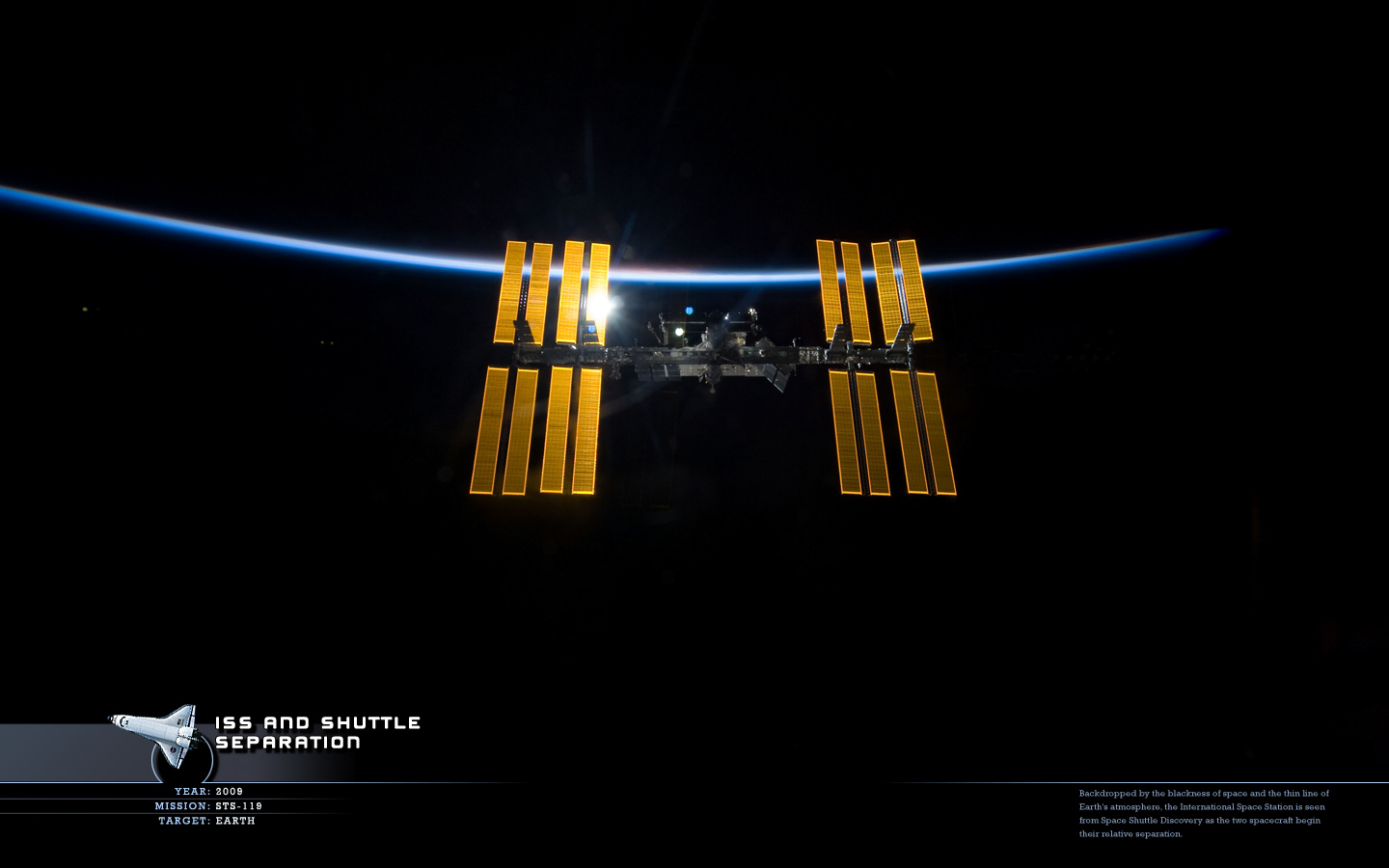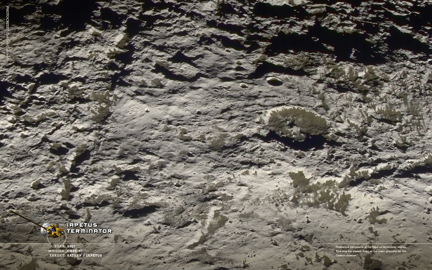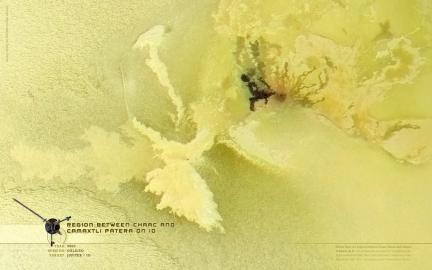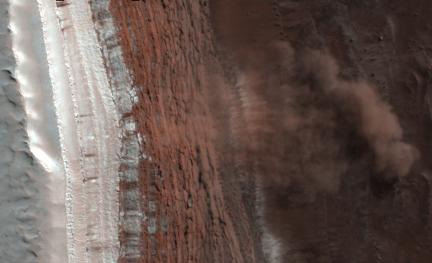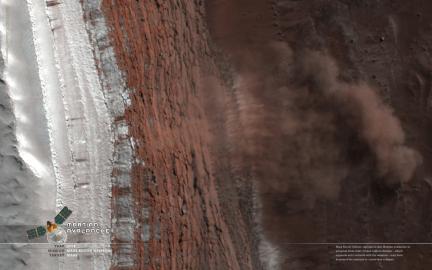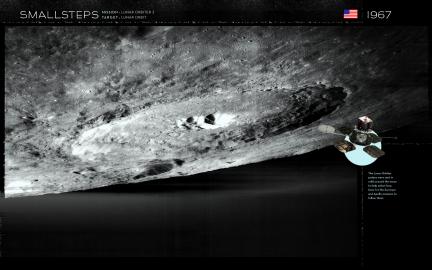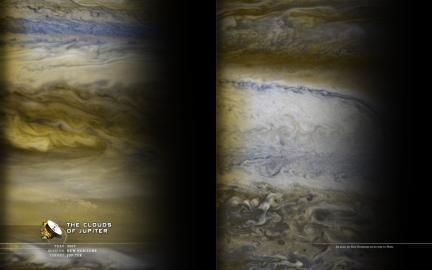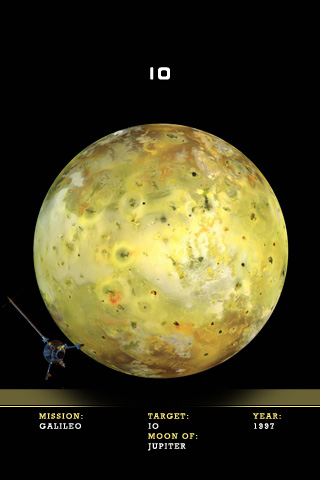 Not to re-post old material, but our iPhone planetary skins were recently posted to fuelyourcreativity.com for free download. So I thought I would just remind everyone and maybe direct a little traffic love their way.
Not to re-post old material, but our iPhone planetary skins were recently posted to fuelyourcreativity.com for free download. So I thought I would just remind everyone and maybe direct a little traffic love their way.
Best Image of ISS Yet
Wallpaper: Frosted Martian Sand Dunes
Wallpapers: The Martian Ganges Chasma
 The Ganges Chasma is a side canyon at one end of the vast Valles Marineris trough system of Mars. This image was returned by ESA’s Mars Express, brought to our attention by Bill Dunford’s Riding with Robots. The image above is a 2560x1800 wallpaper. Download the 1440x900 here.
The Ganges Chasma is a side canyon at one end of the vast Valles Marineris trough system of Mars. This image was returned by ESA’s Mars Express, brought to our attention by Bill Dunford’s Riding with Robots. The image above is a 2560x1800 wallpaper. Download the 1440x900 here.
Wallpaper: Iapetus Terminator
Another work by Gordan Ugarkovic. He created this composite with hi-res clear images (monochrome, that is) and combined that with low quality color data. It is often possible to get a good full color image with low-quality data as long as there exists a good quality clear image to work with. The full composite is here.
I have noticed that Gordan’s work has begun popping up on the Planetary Society blog fairly often. Congratulations to both Gordan for the recognition and to PS for making his gorgeous composites available to the masses!
Volcanic Io Wallpapers
Wallpaper: Io’s Prometheus Volcano
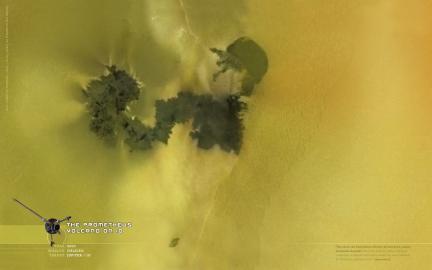 Jason Perry has been featured here a whole bunch lately as he has been uploading newly processed Galileo images nearly every week (not to mention the recent New Horizons set). Some of these images would make great wallpaper displays, but the only issue with some are missing data regions and the noise that is common with hires images from the Galileo mission. Wanderingspace has attempted to artistically replace and clean of few of these images and will be posting the results of these for the next few days.
Jason Perry has been featured here a whole bunch lately as he has been uploading newly processed Galileo images nearly every week (not to mention the recent New Horizons set). Some of these images would make great wallpaper displays, but the only issue with some are missing data regions and the noise that is common with hires images from the Galileo mission. Wanderingspace has attempted to artistically replace and clean of few of these images and will be posting the results of these for the next few days.
The region shown is the most famous of Io’s active volcanoes Prometheus. Normally we see this volcano at the edge of Io’s limb to view the plume clearly on profile, but here Galileo views this very active region from above during a flyby on orbit #27. The reddish haze surrounding the area is either the plume itself jettisoning materials or could also be deposits lying on the ground – perhaps Jason will comment and clarify.
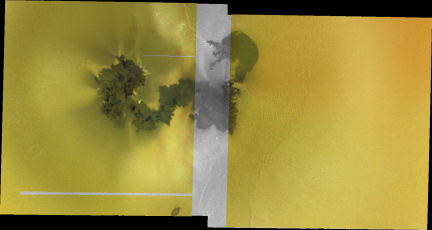
The above image is the Jason Perry original and the missing color information is apparent (only the green channel was provided from the mission). The noise at this scale is less apparent but much more visible on the hires version. It is important to note that the wallpaper version is an artistic attempt at cleaning and replacing the missing data and is meant for display viewing not science!
IMAGE NOTE: As stated above – the missing color data was colorized in the region it was missing and some of the thin strips of missing color data was simply replaced with new image information. You can also see areas at the edges of the composition that were filled with duplicate image data to fill the wallpaper frame most notably at top right and bottom left. The remainder of the image is original except for the noise reduction provided by Photoshop.
Martian Avalanche!
 In the referential image above, two avalanches were captured in action by the Mars Reconnaissance Orbiter. The larger of these two (B) is around 180 meters wide, extends about 190 meters and the cliff heights are around 700 meters tall. The White material on the top that appears as snow is actually carbon dioxide frost which is currently receding as the Martian Spring moves closer. It is this very process which may be the cause of such falls as the carbon dioxide frost expands and contracts with the changing seasonal temperatures. Despite these seasonal changes, most areas of the Martian surface have likely been unchanged for millions of years, so it is quite rare to capture such cataclysmic activities in a single image from orbit.
In the referential image above, two avalanches were captured in action by the Mars Reconnaissance Orbiter. The larger of these two (B) is around 180 meters wide, extends about 190 meters and the cliff heights are around 700 meters tall. The White material on the top that appears as snow is actually carbon dioxide frost which is currently receding as the Martian Spring moves closer. It is this very process which may be the cause of such falls as the carbon dioxide frost expands and contracts with the changing seasonal temperatures. Despite these seasonal changes, most areas of the Martian surface have likely been unchanged for millions of years, so it is quite rare to capture such cataclysmic activities in a single image from orbit.
IMAGE NOTE: The images above are listed as RGB, but the accompanying text describes all the images as “false color”. Guess – maybe it means the colors are natural but exaggerated? See below for 1440x900 landscape wallpaper.
Wallpaper: Mercury Portrait Updated
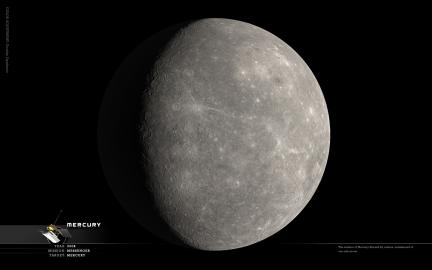 Seemed about time to update the old Mercury “portrait” wallpaper to the new Messenger Mercury “portrait”. It seems possible this color view of Mercury may be replaced again by a better view from the coming October Messenger flyby of Mercury (or perhaps by yet unreleased images from the January flyby), but for now this sure does it.
Seemed about time to update the old Mercury “portrait” wallpaper to the new Messenger Mercury “portrait”. It seems possible this color view of Mercury may be replaced again by a better view from the coming October Messenger flyby of Mercury (or perhaps by yet unreleased images from the January flyby), but for now this sure does it.
NOTE: This is a re-post, the image has been updated with Gordan Ugarkovic’s colors as the official NASA version had a good amounf of false colors which gave many details a blueish hue that would not be visible to human eyes.
Wallpaper: Northern Cloudtops on Saturn
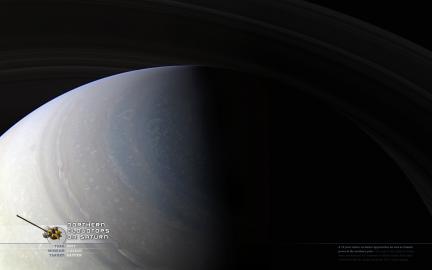 Wallpaper image made from previous post.
Wallpaper image made from previous post.
NOTE: The rings to the right of the terminator were sampled from actual images and rendered out in 3-D software to fill the page. The dark outline of the right side of the globe is artificial. Everything to the left of center is actual image. See previous post for unadulterated version of the image. Color composite and rings are by wanderingspace.net.
Wallpaper: Southern Saturn
The Gordan Ugarkovic fan club must be thrilled this week with all the recent Saturn images. This new one is among the best around, reminiscent of the fantastic Ian Regan composite. A gorgeous view of Saturn’s southern pole which has seen very little exposure in terms of global views (or near global) like this. The now famous “storm” dead-centered around the pole can be seen directly to the left of the image caption.
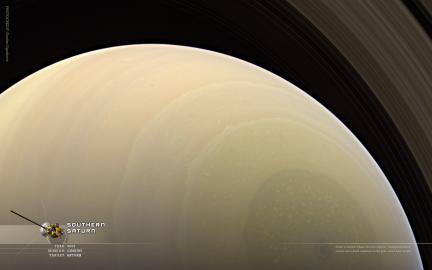
As always, the Ugarkovic flickr page for all the latest.
NOTE: An ever so slight amount of Photoshop image extension was applied to the far right side of the image only at the edge. Probably about .5% of the image.
Smallsteps Wallpaper: Lunar Orbiter 3
Smallsteps Wallpaper: Lunar Orbiter 1
In August 1966 NASA began the Lunar Orbiter series of missions that were intended to get up-close images of smooth areas of the moon suitable for landing both Surveyor unmanned lander probes as well as the eventual manned missions of Apollo. Note that these missions had only begun 3 short years before the successful Apollo 11 mission that saw mankind take its first steps onto the surface of another world… now that is some turn-around time! Lunar Orbiter 1 actually took place while the Surveyor series of missions had already begun. This would suggest that some of the data obtained from the Lunar Orbiter probes were collected and used immediately in the execution of Surveyor missions.
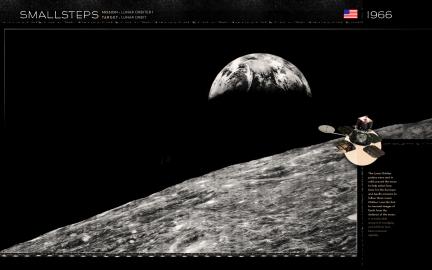
This first Lunar Orbiter mission is credited for returning the first 2 images of Earth as seen from the distance of the moon. Most people refer to these kinds of images as “Earthrise” images, although that description is incorrect in the traditional sense of the word. Since the same side of the moon always faces Earth, an Earthrise is only possible in a Lunar orbiting spacecraft that is in effect chasing the Earth. Down on the surface of the moon… if you can see Earth in the sky, then you will always see Earth in the sky. It will always be in the same place, at the same size and at all times of the Lunar day.
Another STS-118 Image
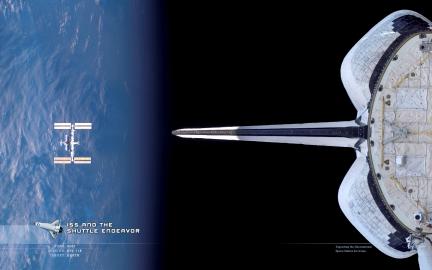 While looking for stunning images from STS-119, came up with this missed gem from 118. Again… was there a photographer on that mission?
While looking for stunning images from STS-119, came up with this missed gem from 118. Again… was there a photographer on that mission?
The iPhone Set 01: Bodies of Major Interest
 If I am going to keep making these things… I’d be a fool to not include a set for the Apple iPhone. Coincidentally, when you purchase your iPhone and do not yet have a phone service, the phone displays a full-disc image of the Earth pretty much displayed exactly as these do when uploaded to your iPhone. So in the spirit of continuity, you can now opt instead to have Mercury, Venus, Earth, The Moon (Luna), Mars, Jupiter, Io, Europa, Ganymede, Callisto, Saturn, Enceladus, Titan, Iapetus, Hyperion, Uranus, Miranda, Neptune or Triton grace your screen instead of the default Earth.
If I am going to keep making these things… I’d be a fool to not include a set for the Apple iPhone. Coincidentally, when you purchase your iPhone and do not yet have a phone service, the phone displays a full-disc image of the Earth pretty much displayed exactly as these do when uploaded to your iPhone. So in the spirit of continuity, you can now opt instead to have Mercury, Venus, Earth, The Moon (Luna), Mars, Jupiter, Io, Europa, Ganymede, Callisto, Saturn, Enceladus, Titan, Iapetus, Hyperion, Uranus, Miranda, Neptune or Triton grace your screen instead of the default Earth.
The easiest way to install wallpapers to your iPhone is to make a special set in iPhoto and simply drag all the files to that folder. Then in iTunes have your iPhone sync that folder to your photos collection. After that it is as simple as opening the “Photos” area of your iPhone. Go to your new folder of images and open whichever image you want. Then tap on the image just once and assign it as a wallpaper using the “Use as Wallpaper” button in the lower left corner of the screen.
If you have a PC I have no idea in hell how the hell you get images into your iPhone. I would buy a Mac… you have an iPhone and use iTunes… you are half-way there.
For a version of these with no graphics see this link.
Wallpaper 2560x1600 Set 03: The Planets
The planets – the complete set for collectors! While there are literally thousands of images of the planets to choose from… full globe high resolution images are actually fairly rare. They usually require many exposures to be stitched together to make one large complete image. This is not only difficult to work out across the great distances of space, but also soaks up a large amount of valuable spacecraft time and energy. This set represents the best available images of each planet in our Solar System.
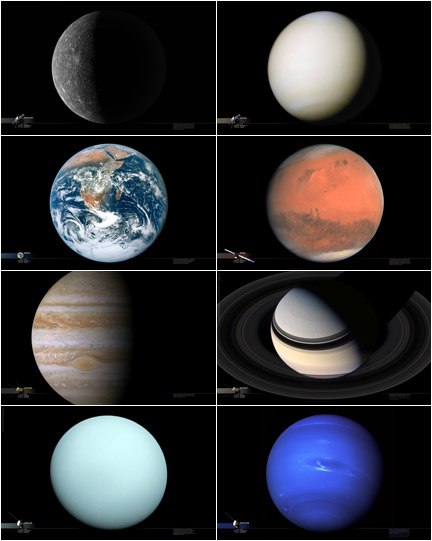
Sorry, no Pluto for more than one reason.
2560 x 1600 Set 05 : Saturn Scenes
Among the various worlds in our celestial neighborhood, Saturn stands apart as a most photogenic. With the help of a complex system of rings it naturally lends itself to more scenic images as compared to the more detail oriented images we see from such other places such as Mars or Jupiter. The “Saturn Scenes” set (downloadable here as a zipped file) was compiled from some of the best scenic images from the Cassini mission that had the potential to fill a 2560x1600 frame.
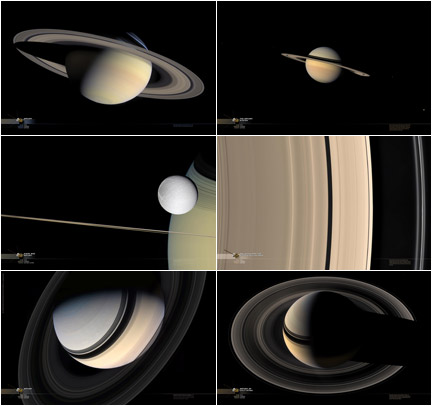
In order to completely fill that frame out some rendering and sampling has been applied to the original images. These additions are briefly noted in the images themselves and are as noted here…
DIONE AND SATURN features the moon Dione passing in front of the edge of Saturn’s disc. The original image would only fill about 1/4 of the frame so some of the details have been sampled and expanded to fill out that full frame’s proportions. The details of the rings are sampled from this image and based upon other photographic references. The left 2/3 of the rings seen here were rendered and are not actual. The lower 1/5 of Saturn’s disc was sampled and extended from the original image. Lastly, the top darkest ring shadows were rendered based upon a fair amount of actual data that was actually present in the original but was cropped short.
SATURN (which is named “SATURN-2.jpg” in the file name) has had a considerable amount of rendering to extend the details of the rings to fill out this larger 2560x1600 frame. The original color composite work was masterfully performed by Ian Regan for unmannedspaceflight.com and has become a wanderingspace favorite. In order to extend the rings to fill out the frame as accurately as possible, a one pixel wide sampling of the full set of rings was captured and digitally translated to vectors. These vectors were then stretched and applied to a circle path which was then rendered in 3-D software to achieve the correct perspective of the original. Once a match was made, the new vector based rings were then blended into the actual original image and some masking was applied to represent Saturn’s shadow falling upon the rings. Despite the heavily rendered nature of the rings, virtually no part of the disc of Saturn itself has been altered and is 99.5% original and actual.
All other images are actual and unaltered.
New Horizons is New Again
A bunch of new data was recently released from the New Horizons encounter with Jupiter in February. Included in that was this impressive composite of Jupiter’s clouds.
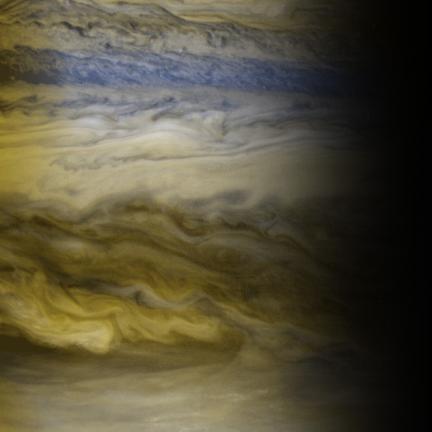
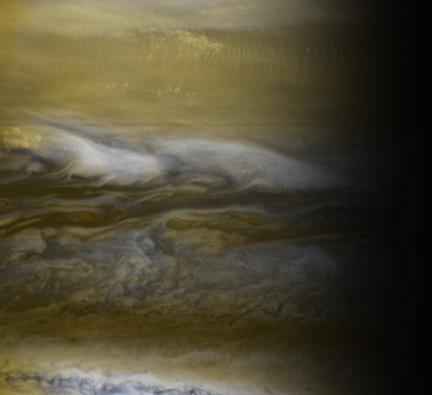
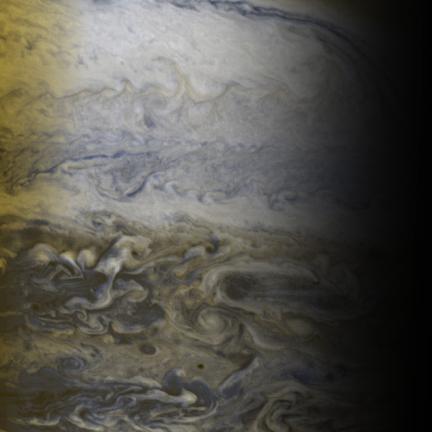 The image is presented here in 3 parts as I just have not figured out how to post tall images in my build of WordPress without it scaling oddly into the page format.
The image is presented here in 3 parts as I just have not figured out how to post tall images in my build of WordPress without it scaling oddly into the page format.
The original released by NASA had an odd grey faded edge which looks fairly fake and manipulated. The description states that it was taken at the edge of Jupiter’s night-side, so we adjusted the above images to look more natural than the way it appeared here.
Smallsteps Wallpaper: Surveyor 1
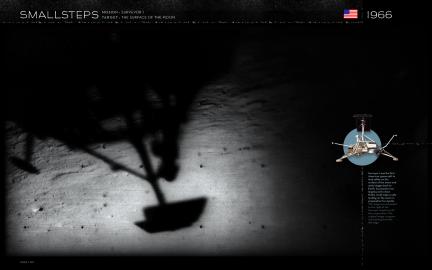 Look at the date on this mission. It’s 1966… 3 years before the Apollo 11 manned landing on the moon. It shows you what we as a species could really do had we the initiative to do it. Just 3 years after landing the first unmanned probe on the surface of the moon… we were ready to send people. That would almost be like sending men to Mars just a few years after Viking landed in 1976. Okay… it is much further away than the moon and many other technical difficulties as well. So lets say that it would been like sending people to Mars 10 years after Viking. That would be 1986 and here we are 20 years after that saying it will still take another 15.
Look at the date on this mission. It’s 1966… 3 years before the Apollo 11 manned landing on the moon. It shows you what we as a species could really do had we the initiative to do it. Just 3 years after landing the first unmanned probe on the surface of the moon… we were ready to send people. That would almost be like sending men to Mars just a few years after Viking landed in 1976. Okay… it is much further away than the moon and many other technical difficulties as well. So lets say that it would been like sending people to Mars 10 years after Viking. That would be 1986 and here we are 20 years after that saying it will still take another 15.
The Surveyor craft was sent to the surface of the moon largely just to prove that we could do it. It was doing what its name suggested… surveying places for Apollo to plant a few flags.
2560 x 1600 Set 02 : The Moons of Jupiter
The moons of Jupiter (well, the 4 major ones) are in their own right, a Solar System within a Solar System. There is volcanically explosive Io; Europa with its cracks and ridges hinting at its huge internal ocean; Ganymede the largest moon in our celestial neighborhood and Callisto one the most heavily cratered bodies we have anywhere. The 4 moons are also called the Galilean moons as they were discovered by Galileo and have since been revealed to be more fascinating than most planets are. The images below represent what I think are likely the best representative images of these places that can fill a 2560x1600 screen. At this size, the details are quite impressive… do take a look even if you can’t make use of the images as wallpaper images.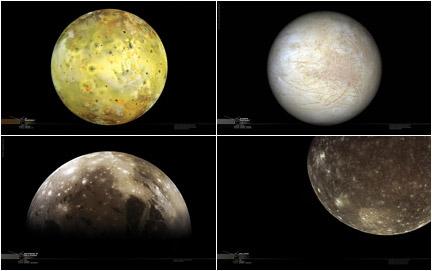
The Europa image is actually a render created by Tayfun Öner as not that many satisfactory images exist of a full globe Europa. Many great images exist of Ganymede but most are low resolutions, this image was stitched together by Ted Stryk of www.unmannedspaceflight.com. The other two are officially released NASA composites.
